The two channel mixer market is absolutely overflowing – and that’s just the crop currently sitting on shop shelves. Delve further back through manufacturers’ portfolios and there’s a near endless line of discontinued yet still perfectly viable mixers going strong in-between innumerable decks. Even though many DJs are moving towards all in one digital setups, it still pays to have a solid DJ mixer around for many purposes. How do you decide what’s right for you?
Why do I need a mixer, you might ask? Well for starters, anyone using DVS technology like Serato or Traktor Scratch needs a mixer for audio control. Then, for the controller only crowd, a mixer can actually offer a great value and a very tactile, high quality control surface. For less than $600 you can get 2 midi-fighters, and a decent 2 channel mixer, and as Ean Golden showed us in the video bellow- there is a lot that can be done with the combo. This set up travels really well too, as the critical software functions go in your bag but the spacious mixer functions are always available in a club.
To many a beginner, a mixer is a mixer (is a mixer). To a certain extent that’s true; bargain basement mixers tend to be much of a muchness, and that muchness typically isn’t particularly high fidelity. There are plenty of sub £100/$150 mixers on the market, but quite often it’s a better value proposition to scout the second hand market for an older, perhaps discontinued mixer with a good reputation.
Things start getting interesting when you hover around the £120/$180 mark. It’s at that price point where products begin to exhibit signs of quality and useful features. But what features do you need? These features, whilst not necessarily exclusive to two channel mixers, suit different styles – figure out what you want to do with your sets and buy based on what they can offer you:
FEATURES
Mic/Aux: some mixers have an entirely separate discrete channel for audio on top of the mixer’s standard inputs. It’s often got slightly cut back EQ capabilities, and volume will be a dial rather than a fader. If you want to drop samples while mixing or throw shout outs to your adoring crowd, though, it’s more than sufficient.
Faders: Unfortunately the days of the two-week fader aren’t completely behind us, and seriously low budget mixers tend to come with faders that don’t stand up very well to the rigours a scratch DJ might like to place upon them. There’s usually at least a half decent crossfader in midrange mixers, though, with channel faders’ presumed less vigorous usage affording them slightly lower faders. ‘Non contact’ faders should in theory last vastly longer than traditional faders, as instead of the fader relying on constantly wearing carbon tracks to tell its position, clever magnetic or optical technology does the same thing with nothing to wear down. A scratch DJ typically puts the crossfader (or its third party compatibility) at the centre of their purchase decision.
EQ: Not all EQ is created equal. A lot of EQ is similar, but some mixers stand out from the pack, for better or worse. ‘Full kill’, ie total frequency isolation, isn’t standard on all mixers and so the effectiveness varies amongst them. Some mixers, typically budget ones, only have a two band EQ. Some (like the Technics on show below) have a certain pleasant quality to the way they EQ the sound. EQ’s importance varies depending on your style – a sacrifice here could mean a bonus on one of the other functions.
Effects: You don’t need a four channel mixer to enjoy effects! That said, effects laden mixers do tend to come at a premium. If you’re a beginner it might be a good idea to concentrate on the basics when starting out. In addition, you might not see a mixer with the exact kind of effects you’re after; in both of these situations, a send/return could be the answer…
Send/Return: Does what it says on the tin – audio goes out through the send, at which point it’s connected to whatever you like – let’s say a reverb. The output from the reverb then goes into the return, and the signal is mixed with the original one. A mixer with a good send/return (sometimes called an effects loop) allows you to expand your setup with whatever effects you like.
Fader Start: Depending on your style and other equipment, fader start could be either be totally useless or, well, a bit useful. If your CD/media player also has a fader start function, moving the crossfader towards the channel it’s plugged in to can also start the media playing.
I’ve defined five price points for this guide; introductory, mid range, hybrid, prestige, and wait-a-second-how-much? Rather than exhaustively tackling every mixer on the market, I’ve picked some of the ones that stand out in each class. Let’s start at the bottom and work our way up…
INTRODUCTORY ( UNDER £120/$150)
The American Audio Q D5 MkII boasts EQs with full kill, an optical crossfader, mic and aux in, and balanced output. For the price, the Q D5 MkII is tough to beat. It’s slightly harsh sounding, but the crossfader’s optical design lasts a lot longer and feels a lot smoother than low quality contact faders, the mic input is good, and it’s got a sturdy, if slightly light feel.
Vestax’s VMC002XL is a beginner oriented mixer, with good looks and ‘new Vestax’ sound quality. Its barebones feature set doesn’t exactly have the wow factor, but it’s built to a higher standard than most budget mixers.
MID RANGE (UNDER £300/$400)
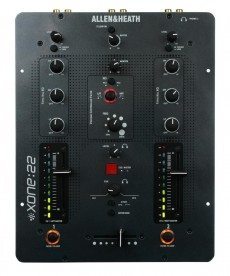 The Allen & Heath Xone 22 is a mix DJ focused mixer, with a crowded appearance compared to most two channel competition. However, smooth, long mixing style DJs will appreciate its long faders and inclusion of the famous Allen & Heath analogue filter, as well as Allen & Heath quality headroom.
The Allen & Heath Xone 22 is a mix DJ focused mixer, with a crowded appearance compared to most two channel competition. However, smooth, long mixing style DJs will appreciate its long faders and inclusion of the famous Allen & Heath analogue filter, as well as Allen & Heath quality headroom.
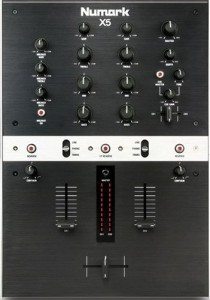 Numark’s X5 is a tank of a mixer, with three great faders, serious sound quality, looks to die for and a top notch input/output section. However, it’s lacking an effects loop. Its no nonsense layout and choice faders mean that for scratch DJs, the X5 is a serious contender.
Numark’s X5 is a tank of a mixer, with three great faders, serious sound quality, looks to die for and a top notch input/output section. However, it’s lacking an effects loop. Its no nonsense layout and choice faders mean that for scratch DJs, the X5 is a serious contender.
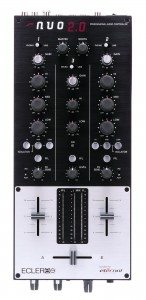 The Ecler Nuo 2.0 is a slimline mixer with Ecler quality sound, a third, mic/aux switchable input, well implemented FX loop, and crossfader circuitry compatible with the Eternal fader. Its big, soft feeling pots are also fun to use.
The Ecler Nuo 2.0 is a slimline mixer with Ecler quality sound, a third, mic/aux switchable input, well implemented FX loop, and crossfader circuitry compatible with the Eternal fader. Its big, soft feeling pots are also fun to use.
HYBRID (UNDER £400/$400)
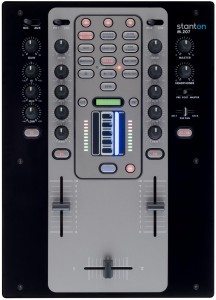 Enter Stanton’s M207. Once outside of bargain basement territory, most mixers in the two channel market tend to pander to scratch DJs at the expense of other features. The M207 goes in the other direction – its channel faders are long and its crossfader can’t compete with other manufacturers’ proprietary contactless designs, but to make up for it it has a full featured effects and sampler section. Operated by a selection of buttons but also putting Stanton’s touch pad R&D into use, the M207 is a different beast to most mixers in the market.
Enter Stanton’s M207. Once outside of bargain basement territory, most mixers in the two channel market tend to pander to scratch DJs at the expense of other features. The M207 goes in the other direction – its channel faders are long and its crossfader can’t compete with other manufacturers’ proprietary contactless designs, but to make up for it it has a full featured effects and sampler section. Operated by a selection of buttons but also putting Stanton’s touch pad R&D into use, the M207 is a different beast to most mixers in the market.
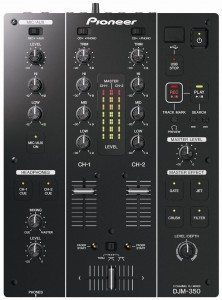 Pioneer have a lot of four channel mixers, but the DJM350 is their two channel go between, targeted at the bedroom user who wants to acquaint themselves with the Pioneer way in preparation for an upgrade. Faders and EQs feel and sound like the larger DJM models, although the effects implementation is slightly different. Still, the sound is familiar, and if you’re a mix DJ who wants to use effects, this might be worth a look.
Pioneer have a lot of four channel mixers, but the DJM350 is their two channel go between, targeted at the bedroom user who wants to acquaint themselves with the Pioneer way in preparation for an upgrade. Faders and EQs feel and sound like the larger DJM models, although the effects implementation is slightly different. Still, the sound is familiar, and if you’re a mix DJ who wants to use effects, this might be worth a look.
PRESTIGE (£400/$400+)
 The Vestax PMC05 Pro4 is the latest in a long line of mixers to bear the 05 moniker, but this incarnation has moved from the scratch centric mid quality efforts of the ProII and ProIII iterations firmly into prestige territory. Vestax’s new fader is superb, and the build quality of the unit is noteworthy. Sound quality builds on the PMC08 with much improved EQ and output over the 05/07 generation of Vestax scratch mixers, but the USP of the 05 Pro4 is its MIDI functionality. Six buttons on each side of the mixer can control functions in your favourite DJ software – but on top of that, the channel faders, crossfader, and transform switches can too.
The Vestax PMC05 Pro4 is the latest in a long line of mixers to bear the 05 moniker, but this incarnation has moved from the scratch centric mid quality efforts of the ProII and ProIII iterations firmly into prestige territory. Vestax’s new fader is superb, and the build quality of the unit is noteworthy. Sound quality builds on the PMC08 with much improved EQ and output over the 05/07 generation of Vestax scratch mixers, but the USP of the 05 Pro4 is its MIDI functionality. Six buttons on each side of the mixer can control functions in your favourite DJ software – but on top of that, the channel faders, crossfader, and transform switches can too.
Ecler’s HAK 360 and HAK 380 are similar mixers with different design choices. The 360 uses a horizontal layout for its EQ section, whereas the 380 opts for a more standard vertical layout, and slightly chunkier knobs. Both use the propietary Eternal magnetic crossfader, probably the lightest and most precise fader on the market, and unfortunately both also implement an FX loop in slightly clumsy ways. The 360 allows the effect to be simply on or off, with no wet/dry adjustment, whilst the 380 implements its FX loop globally, rather than per channel. Other than that, the HAK 360 and 380 have a mic/aux channel, full kill EQ and impeccable sound quality.
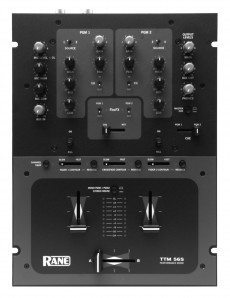 The Rane TTM56S features Rane’s own slick magnetic faders, terrific sound quality, and totally switchable inputs – up to four phono inputs or alternatively four line inputs can be selected. The FlexFX effects loop is one of the best send return implementations available, too.
The Rane TTM56S features Rane’s own slick magnetic faders, terrific sound quality, and totally switchable inputs – up to four phono inputs or alternatively four line inputs can be selected. The FlexFX effects loop is one of the best send return implementations available, too.
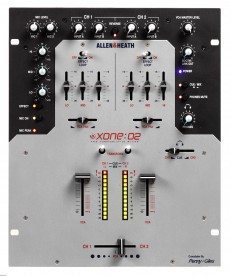 Allen & Heath’s Xone 02 has formidable sound quality and superb build quality, and some nice features such as individually adjustable input levels for the phono/line sections, fader based EQs and dual input mic channel with three band EQ. Its FX loop has no wet/dry, though, and its EQ knobs are a little fiddly. The 02 has a Penny and Giles crossfader, and whilst an excellent feel its sharpness is slightly behind the curve (pun intended) when compared to newer technologies. The 2:02 is the same mixer as the 02 with a much more adjustable ProX fader inside, and for better or worse, a ‘cool’ faceplate.
Allen & Heath’s Xone 02 has formidable sound quality and superb build quality, and some nice features such as individually adjustable input levels for the phono/line sections, fader based EQs and dual input mic channel with three band EQ. Its FX loop has no wet/dry, though, and its EQ knobs are a little fiddly. The 02 has a Penny and Giles crossfader, and whilst an excellent feel its sharpness is slightly behind the curve (pun intended) when compared to newer technologies. The 2:02 is the same mixer as the 02 with a much more adjustable ProX fader inside, and for better or worse, a ‘cool’ faceplate.
WAIT-HOW-MUCH-DID-YOU-SAY?! (£$!!!)
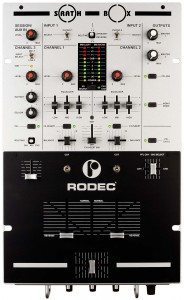 Rodec’s Scratchbox is the concorde of two channel mixers. Built from the ground up to be the ultimate turntablist mixer with no compromises, its tank like construction, superb faders, excellent implementation of all its features and legendary Rodec sound quality. However, it really is for those who absolutely need to know they have the best – it’s very, very pricey.
Rodec’s Scratchbox is the concorde of two channel mixers. Built from the ground up to be the ultimate turntablist mixer with no compromises, its tank like construction, superb faders, excellent implementation of all its features and legendary Rodec sound quality. However, it really is for those who absolutely need to know they have the best – it’s very, very pricey.
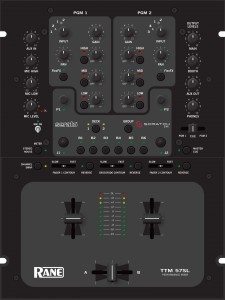 The Rane TTM57SL is Rane’s all in one solution for Scratch Live users. Based on the TTM56, it also contains the equivalent of the SL1 hardware inside it, meaning that a USB connection to a computer is all you need for Scratch Live. A control panel for Scratch Live software functions allows you to utilise cues, effects and track management, and of course the mixer can be used in standalone mode as well. It’s worth bearing in mind that the SL1 has been overtaken in features and quality by the SL3 since the 57SL was released, and that it might well be easier to take around a DVS box than it is a complete mixer to the club.
The Rane TTM57SL is Rane’s all in one solution for Scratch Live users. Based on the TTM56, it also contains the equivalent of the SL1 hardware inside it, meaning that a USB connection to a computer is all you need for Scratch Live. A control panel for Scratch Live software functions allows you to utilise cues, effects and track management, and of course the mixer can be used in standalone mode as well. It’s worth bearing in mind that the SL1 has been overtaken in features and quality by the SL3 since the 57SL was released, and that it might well be easier to take around a DVS box than it is a complete mixer to the club.
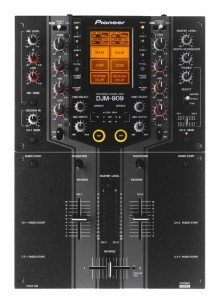 Pioneer’s DJM909 has a big USP – it has onboard, touchscreen, fader operable and per channel effects. Sound quality is as good as you’d expect from the top flights of the DJM series, and the touch screen helps to make sure that the mixer, for all its features, doesn’t get too cramped. The proprietary optical crossfader has tension and lag adjust, but all this adds up and makes the DJM909 a very expensive proposition.
Pioneer’s DJM909 has a big USP – it has onboard, touchscreen, fader operable and per channel effects. Sound quality is as good as you’d expect from the top flights of the DJM series, and the touch screen helps to make sure that the mixer, for all its features, doesn’t get too cramped. The proprietary optical crossfader has tension and lag adjust, but all this adds up and makes the DJM909 a very expensive proposition.
NEARLY NEW
Blame, or depending on how you look at it, praise our fickle nature. Manufacturers are forever tweaking and tuning their product lineup, and over the past decade there have been a glut of mixers that manufacturers threw into the market to see what stuck. Most of them have been retired, but their ghosts live on in the second hand market, and if you’re on a budget then you could net yourself a huge bargain by going previous-season. As always, you need to be careful whenever buying second hand, and if possible get your hands on gear first before shelling out – but if you do decide to go down the preowned route, here are a few hot tips.
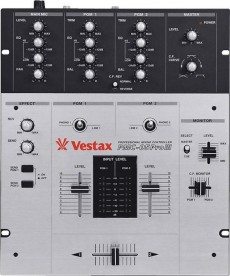 Vestax 05s – there are a whole bunch of mixers in the PMC05 range -some of which can still be found new. All from mark II onwards share similar characteristics – PCV crossfaders, the old gold standard of scratch faders, two band EQ and average sound quality. There are bog standard models, a model with send/return, one with a sampler/delay, and the newest has fully VCA circuitry for slightly better sound. A bog standard one can be had for less than £80, one with the sampler/delay or send/return is sometimes seen for £150. There’s also the Samurai or D series version of the 05, which features a very light crossfader and some digital gimmickry, but they’re even less viable purchases on the second hand market than they were new.
Vestax 05s – there are a whole bunch of mixers in the PMC05 range -some of which can still be found new. All from mark II onwards share similar characteristics – PCV crossfaders, the old gold standard of scratch faders, two band EQ and average sound quality. There are bog standard models, a model with send/return, one with a sampler/delay, and the newest has fully VCA circuitry for slightly better sound. A bog standard one can be had for less than £80, one with the sampler/delay or send/return is sometimes seen for £150. There’s also the Samurai or D series version of the 05, which features a very light crossfader and some digital gimmickry, but they’re even less viable purchases on the second hand market than they were new.
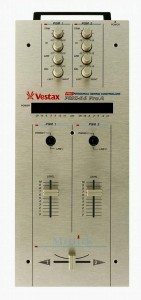 Vestax 06s – similarly, there are a few types of 06, which are essentially an 05 in a slimline form. However, the 06’s differences boil down to colour and whether they are fully VCA or the original ProA offering. One important thing to note about the 06 is that without modification there’s no post fader headphone cueing. Look to pay less than £80/$140.
Vestax 06s – similarly, there are a few types of 06, which are essentially an 05 in a slimline form. However, the 06’s differences boil down to colour and whether they are fully VCA or the original ProA offering. One important thing to note about the 06 is that without modification there’s no post fader headphone cueing. Look to pay less than £80/$140.
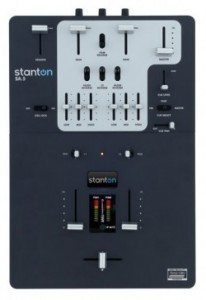 Stanton SA5 – the only mixer with a totally fader based design, the SA5 looks good, sounds great and has a Penny and Giles crossfader. It’s built to last, too. Look for less than £140/$220
Stanton SA5 – the only mixer with a totally fader based design, the SA5 looks good, sounds great and has a Penny and Giles crossfader. It’s built to last, too. Look for less than £140/$220
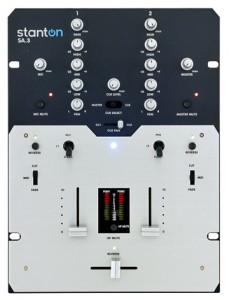 Stanton SA3 – a beginner focused mixer, but with a nice design and fairly good quality all around, they beat out most budget mixers on the market now. Look for less than £60/$100
Stanton SA3 – a beginner focused mixer, but with a nice design and fairly good quality all around, they beat out most budget mixers on the market now. Look for less than £60/$100
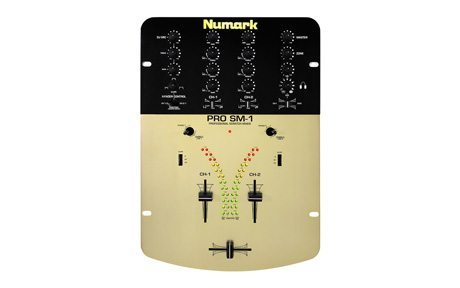 Numark Pro SM1/2 – cheap and cheerful, they may not be the best mixers but they have a good crossfader and pretty good audio quality – importantly, you can pick one up for next to nothing if you can find one and they’re usually better than new low budget mixers. Look for less than £60/$80
Numark Pro SM1/2 – cheap and cheerful, they may not be the best mixers but they have a good crossfader and pretty good audio quality – importantly, you can pick one up for next to nothing if you can find one and they’re usually better than new low budget mixers. Look for less than £60/$80
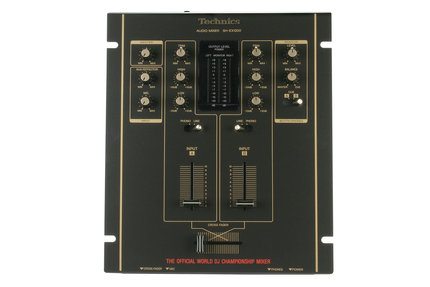 Technics SH-EX1200 – not the greatest crossfader cut in but it was workable for DMC championships for years. Interesting, slightly resonant 2 band EQ leading to pleasant effect, great build quality. Can sometimes be had for a song – but look for less than £150/$250
Technics SH-EX1200 – not the greatest crossfader cut in but it was workable for DMC championships for years. Interesting, slightly resonant 2 band EQ leading to pleasant effect, great build quality. Can sometimes be had for a song – but look for less than £150/$250
SUMMING UP
You’d be right to remark that there’s a void between the £120/$180 and £300/$400 classes of mixers. Whilst it’s not immediately clear why, the general industry move towards the forked path of four channel mixers/in the box mixing perhaps has something to do with it, but it also has a lot to do with the fact that real pro quality doesn’t come cheap, and manufacturers are a lot more cautious with their pricing and product lineup nowadays than they were in the mid 2000s.
It might not be a cut and dry decision, but if you make sure you don’t get swayed by flashing lights and too-good-to-be-true prices of budget models nor the best-in-class boasts of the prestige models, you can avoid buyers remorse and grab a mixer that’s just right for you.
About the author: Chris is a writer, artist and DJ who runs ohdratdigital.com, an online magazine for music and the arts.


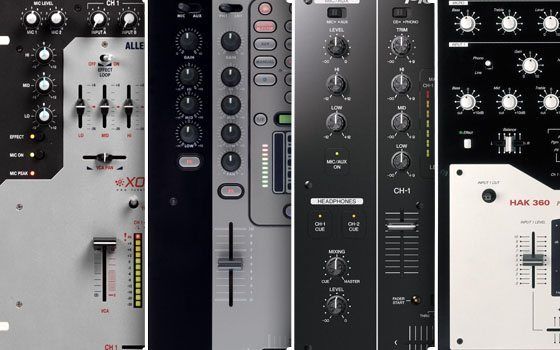
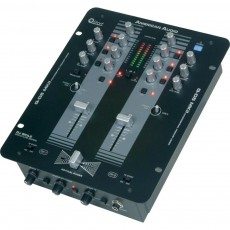
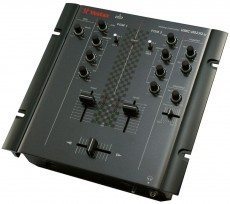
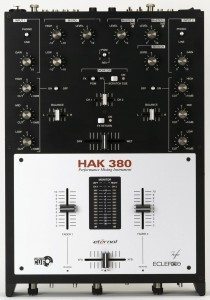
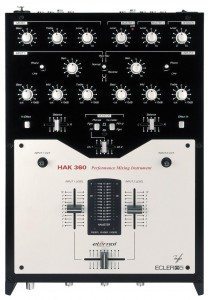

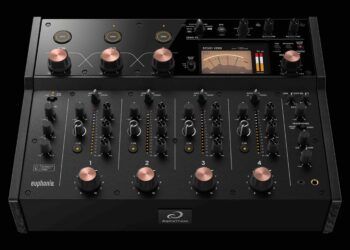
![ROLI’s Seaboard RISE 2: seamless integration into the expressive world of MPE [REVIEW]](https://s11234.pcdn.co/wp-content/uploads/2023/11/Screenshot-2023-11-16-at-5.02.41-pm.png)



